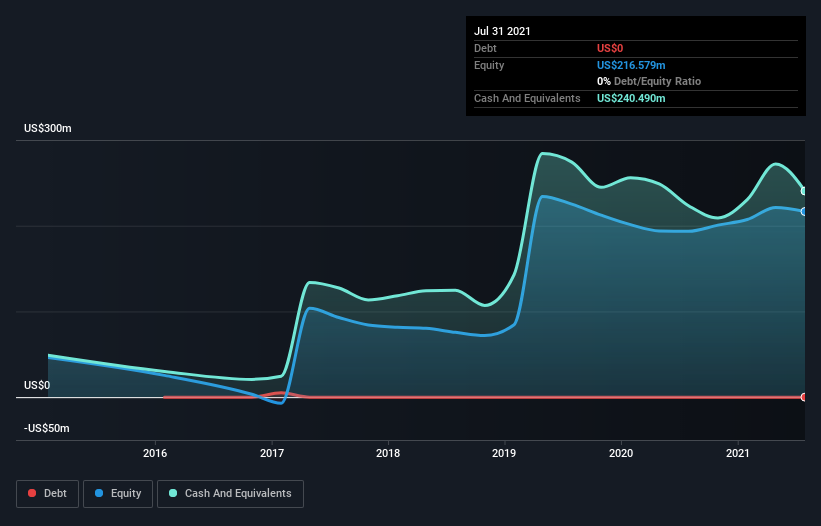- United States
- /
- Software
- /
- NYSE:YEXT
We're Interested To See How Yext (NYSE:YEXT) Uses Its Cash Hoard To Grow

Even when a business is losing money, it's possible for shareholders to make money if they buy a good business at the right price. For example, biotech and mining exploration companies often lose money for years before finding success with a new treatment or mineral discovery. But while the successes are well known, investors should not ignore the very many unprofitable companies that simply burn through all their cash and collapse.
So, the natural question for Yext (NYSE:YEXT) shareholders is whether they should be concerned by its rate of cash burn. For the purpose of this article, we'll define cash burn as the amount of cash the company is spending each year to fund its growth (also called its negative free cash flow). Let's start with an examination of the business' cash, relative to its cash burn.
Check out our latest analysis for Yext
How Long Is Yext's Cash Runway?
A company's cash runway is calculated by dividing its cash hoard by its cash burn. As at July 2021, Yext had cash of US$240m and no debt. Looking at the last year, the company burnt through US$16m. That means it had a cash runway of very many years as of July 2021. Notably, however, analysts think that Yext will break even (at a free cash flow level) before then. In that case, it may never reach the end of its cash runway. You can see how its cash balance has changed over time in the image below.

How Well Is Yext Growing?
Happily, Yext is travelling in the right direction when it comes to its cash burn, which is down 81% over the last year. And while hardly exciting, it was still good to see revenue growth of 12% during that time. It seems to be growing nicely. Clearly, however, the crucial factor is whether the company will grow its business going forward. So you might want to take a peek at how much the company is expected to grow in the next few years.
Can Yext Raise More Cash Easily?
We are certainly impressed with the progress Yext has made over the last year, but it is also worth considering how costly it would be if it wanted to raise more cash to fund faster growth. Companies can raise capital through either debt or equity. Commonly, a business will sell new shares in itself to raise cash and drive growth. We can compare a company's cash burn to its market capitalisation to get a sense for how many new shares a company would have to issue to fund one year's operations.
Yext's cash burn of US$16m is about 1.0% of its US$1.6b market capitalisation. So it could almost certainly just borrow a little to fund another year's growth, or else easily raise the cash by issuing a few shares.
So, Should We Worry About Yext's Cash Burn?
It may already be apparent to you that we're relatively comfortable with the way Yext is burning through its cash. For example, we think its cash runway suggests that the company is on a good path. Its weak point is its revenue growth, but even that wasn't too bad! It's clearly very positive to see that analysts are forecasting the company will break even fairly soon. Taking all the factors in this report into account, we're not at all worried about its cash burn, as the business appears well capitalized to spend as needs be. Taking an in-depth view of risks, we've identified 3 warning signs for Yext that you should be aware of before investing.
Of course Yext may not be the best stock to buy. So you may wish to see this free collection of companies boasting high return on equity, or this list of stocks that insiders are buying.
New: Manage All Your Stock Portfolios in One Place
We've created the ultimate portfolio companion for stock investors, and it's free.
• Connect an unlimited number of Portfolios and see your total in one currency
• Be alerted to new Warning Signs or Risks via email or mobile
• Track the Fair Value of your stocks
This article by Simply Wall St is general in nature. We provide commentary based on historical data and analyst forecasts only using an unbiased methodology and our articles are not intended to be financial advice. It does not constitute a recommendation to buy or sell any stock, and does not take account of your objectives, or your financial situation. We aim to bring you long-term focused analysis driven by fundamental data. Note that our analysis may not factor in the latest price-sensitive company announcements or qualitative material. Simply Wall St has no position in any stocks mentioned.
Have feedback on this article? Concerned about the content? Get in touch with us directly. Alternatively, email editorial-team (at) simplywallst.com.
About NYSE:YEXT
Yext
Provides a platform that offers answers to consumer questions in North America and internationally.
Undervalued with excellent balance sheet.
Similar Companies
Market Insights
Community Narratives



